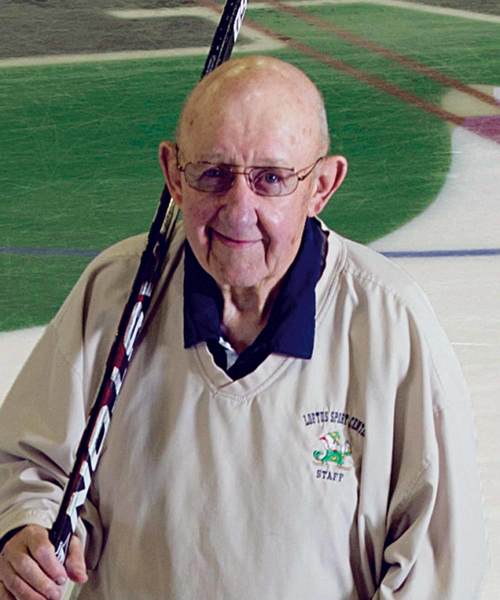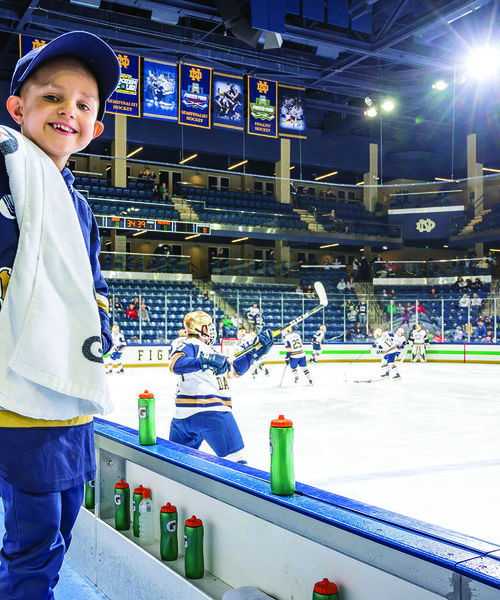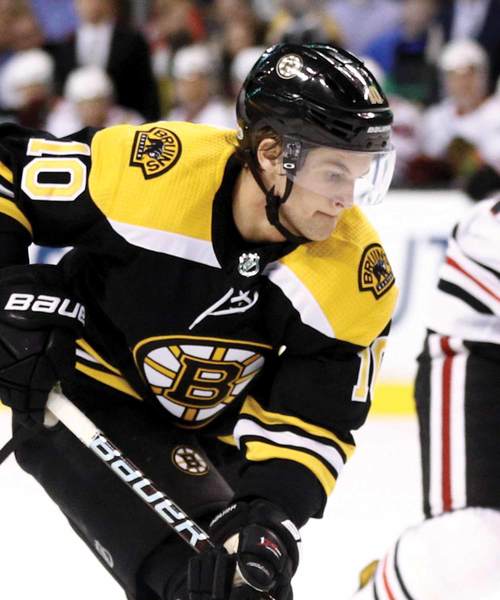
Lefty Smith
Never a cause that wasn’t good enough
The Lefty Smith story is not as much about hockey as it is about people.
Even as Fighting Irish hockey is back near the top of the college game and migrated to the expansive and well-dressed Compton Family Ice Arena this autumn, it is impossible to talk about Notre Dame hockey without acknowledging Smith’s accomplishments.
Charles W. “Lefty” Smith Jr. established Notre Dame’s hockey program and coached the Irish skaters for 19 seasons. He ran the ice rink at the Joyce Center when it opened in 1968, and the venue bore his name when the final horn sounded there this past fall. Smith, a native Minnesotan, organized the Irish Youth Hockey League, bringing the sport to South Bend, Ind.
Still, Lefty Smith is really about people.
Smith is old-school Notre Dame. He was hired in 1968 by Moose Krause and Rev. Edmund Joyce, C.S.C. In time he moved among the legends, came to represent the traditions, became an ambassador of the sport, and not just locally but also nationally. Yet he’s never lost his humility or his human touch.
Smith, who retired from the University in December 2011, started as a high school hockey coach in South St. Paul in 1953, first as an assistant then taking over as head coach in 1958. In the decade prior to being courted by Notre Dame, his fabled prep teams went 201-69-11. He had turned down other college offers, but he came to Notre Dame, he told me once, because the school cared about its athletes as people, developed the whole person, did it right.
He was undaunted by the challenges awaiting him here: taking over a club sport on its way to varsity status, bringing hockey to Indiana, getting athletes to Notre Dame and classes, succeeding against the nation’s top programs and operating the ice rink at Notre Dame’s brand-new Athletic and Convocation Center (from maintaining the arena to managing the concessions to scheduling ice time for his teams, classes, the public and eventually the kids whose youth leagues he started).
Smith’s first Irish team went 16-8-3. In 1972, its second year in the Western Collegiate Athletic Association (WCHA), Notre Dame finished second in the 10-team league and lost a one-point decision in the playoffs to Wisconsin, the eventual national champion. In 1976–77, the Irish again finished second in the WCHA and finished third nationally. Smith was named the WCHA Coach of the Year both years.
The following year, writing a profile of Smith as my first story for Notre Dame Magazine, I attended my first hockey game; Smith asked me to join him and the team on the bench. His wife, Mickey (who passed away in 2009), was in her usual back-row seat, standing the entire game. Six of their eight children were there, “making hockey a family sport for the Smiths,” I wrote then. I also quoted the coach saying, “Every year is extremely satisfying for me because I am working with 25 or 30 people. The most interesting aspect is seeing the great strides they take as human beings, seeing them mature and become a cohesive group.”
However rarely our paths crossed after that, Smith always knew my name, treated me like an old friend. And I always saw in him the essential character of the institution.
Later that year Smith coached the Central team at the National Sports Festival. Eight of his players would become members of the gold medal-winning 1980 U.S. Olympic team. In 1981–82, the Irish moved to the Central Collegiate Hockey Association (CCHA) where Smith guided the Irish to the Great Lakes Invitational championship and the CCHA championship that season.
Smith retired from coaching in 1987. Notre Dame was readjusting its athletic programs, and hockey scholarships were cut. But his legacy shines. His Fighting Irish teams won 307 games. He produced six All-Americans and a handful of NHL standouts, and all 126 players who skated for him completed their college eligibility and earned college degrees. In 2003 he was named a “Legend of Hockey,” by the Hobey Baker Memorial Award Foundation.
Still, it wasn’t easy to leave the game he had fallen in love with as a boy.
Growing up in South St. Paul, Smith had played some football and had gotten his nickname as a southpaw pitcher (good enough to play semi-pro with Bill “Moose” Skowron, Sad Sam Jones and some other future major leaguers), and he had skated on frozen ponds and lakes, but had never witnessed the Canadian sport being played live. So at 15, he and some buddies headed off to Minneapolis in 1945 to see the state’s first high school hockey tournament. He loved the game’s speed, power, finesse and body-banging contact.
As a high school junior, Smith set the course for a lifelong journey: He brought people together using hockey as the common bond. He petitioned the South St. Paul school board for a hockey team and got $600 to get things started, plus the promise of a “rink” in an open field that the city agreed to keep flooded throughout the winter.
Smith and his young cohorts spent their first year learning the game. They learned well: In their second season they made the state tournament and won the consolation bracket.
Smith became a star defenseman at St. Thomas College in St. Paul and, while there, started a citywide youth program. After a brief stint with Minnesota in the U.S. Hockey League, he took his skills and passions into coaching.
When that career ended in 1987, Smith took over as director of Notre Dame’s new Loftus Sports Center, managing the facility that provided indoor practice areas for various varsity sports and open spaces for ROTC and the marching band as well as recreational opportunities for students, families and the public to walk, jog or pedal a stationary bicycle. Smith really believed in that multipurpose philosophy and for years the place would bustle and hum with fleet runners, elderly walkers and pickup games of touch football and Frisbee.
Occasionally, during the long South Bend winters, my sons and I would ask Lefty if we could hit balls in the batting cage that dropped from the ceiling. Most times he’d say OK, even though it was against the rules. I knew it was against the rules because everyone else who worked there said so, citing insurance and liability concerns. Lefty made the exception.
Lefty Smith is a good man. He’s his own person, centered, grounded, comfortable in his own skin—“salt of the earth,” one friend says. He got his impressive work ethic growing up in the 1930s, was an adolescent when his father went to war, seeing combat in Italy, injured in France.
Today, Smith’s office walls are covered with pictures of people. Lots of hockey greats, evidence of Smith’s stature in the game. But mostly it’s former players. Walls plastered with former players who have married and had kids. His former players send him photos of their children. Then, too, there are pictures of Ara and Moose, Rev. Jim Riehle, C.S.C., and others—people who are part of the fabric of the place. Smith is woven tightly into that fabric, too.
The sign on his door says: “Lack of planning on your part does not constitute an emergency on mine.” He’s no-nonsense, too, straight-talking, unadorned. There’s not much extravagance in Lefty Smith—except inside.
He got involved with Special Olympians in 1980. He helped bring ice skating and hockey into the games designed for special-needs individuals. He put on clinics and got engaged. He gave to it like he had given to other people throughout his life, using sport as the common bond.
In 1983, Smith, then president of the College Hockey Coaches Association, and Bill Locke Sr., then recreation director for the local Council for the Retarded, went to Baton Rouge, La., for the games there, and returned vowing to bring the International Special Olympics to South Bend in 1987. Not only was Smith instrumental in making that dream come true, he directed the 22,000 volunteers and 6,000 Special Olympians from 72 nations during the 12-day event hosted on the Notre Dame campus.
Still, when I think of Lefty Smith, I picture him having lunch at the Algonquin Table at the University Club all those years. The tradition started in 1968 when the ACC opened and a group of faculty and staff began playing noontime pickup hockey games. They’d skate together a couple of days a week and eat together on other days. The name came from the Round Table at New York’s Algonquin Hotel where a cast of writers, actors, critics and wits met to dine and trade opinions, tales and barbs.
Notre Dame’s version included folks from the athletic department, WNDU and faculty. James Carberry and Father Riehle were regulars, as was Lefty. They were there daily when the bodies outgrew the games, the round table in the corner, swapping jokes and insider scoops and opinions on the state of the University. It was a fraternity of love and respect and laughter, a tradition of collegiality and good humor.
When the University Club closed, it was Smith who slipped into the place at dawn to make sure the table got transferred to Legends to keep the camaraderie alive. The coach always knew it was the people who mattered most.

